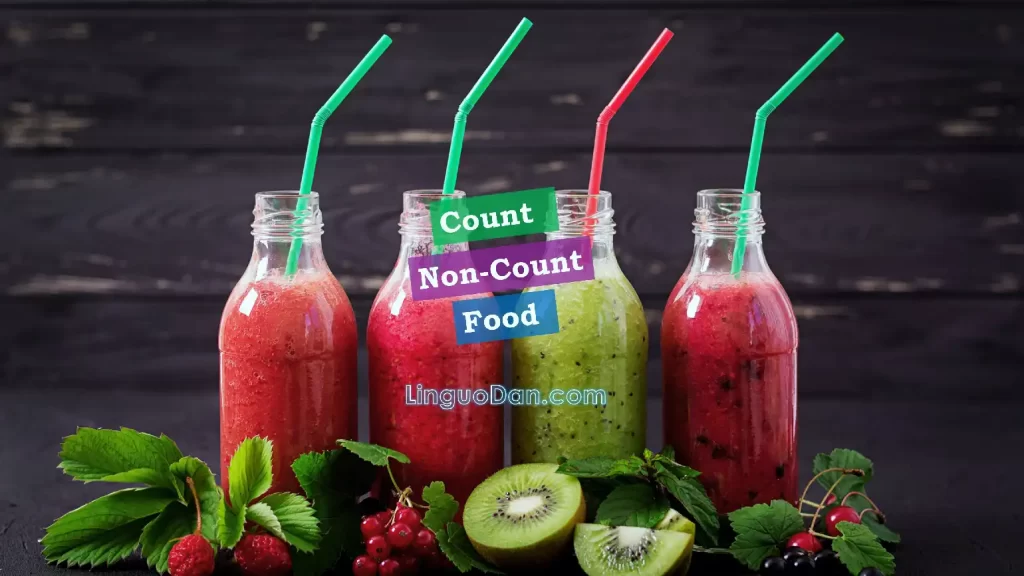Countable and uncountable nouns – practice

Countable and non-countable nouns in English
Count Nouns in English – these are nouns that can be counted. They can be singular or plural. You can use numbers with them. For example, you can have “one apple” or “two apples”.
Non-Count Nouns – these refer to substances, concepts, or things that cannot be counted and usually don’t have plural forms. Examples are liquids, powders, gases, phenomena or abstract ideas. Words like “milk”, “sugar”, “happiness” are not used in plural forms, and you cannot say “one milk” or “two sugars” in the conventional sense.
Today we will look at Count/Non-Count Food Quantities – that is, words and phrases used to describe amounts of food. First, let’s quickly review the difference between count and non-count nouns. Then we will learn some new vocabulary for food quantities, look at their meanings and usage examples. Finally, we’ll do an exercise with 20 questions to test our knowledge.
Basic rules of countable and uncountable nouns
Count Nouns:
- Used for nouns that can be counted.
- Typically used with numbers (one, two, three, etc.) or other words indicating quantity (a, an, many, few, several).
Examples:
- “a loaf of bread”
- “two cups of coffee”
- “three eggs”
Non-Count Nouns:
- Used for nouns representing a substance or abstract idea that cannot be counted precisely.
- Typically used without numbers or with words like some, any, much, little.
Examples:
- “a glass of water” (Countable because glasses can be counted)
- “some milk” (Uncountable because milk is an abstract substance)
Use of Articles:
- Count nouns generally take articles before them (a, an, the) depending on context and intention.
- Non-count nouns may be used without an article or with “some” or “any”.
Examples:
- “a cup of tea” (countable)
- “some sugar” (uncountable)
Units of Measurement:
- Count nouns are used with specific units of measurement (pound, quart, dozen, etc).
- Non-count nouns can be used without specific units or with words like “some” or “any”.
Examples:
- “a pound of cheese” (countable)
- “some butter” (uncountable)
By applying these rules, you can better understand how to use countable and uncountable nouns, which will help you solve test questions.
Countable and uncountable nouns used for food
Loaf:
- Pronunciation: /loʊf/
- Explanation: This word refers to a single large piece of something, like bread or a meat sausage.
- Example: “I bought a loaf of bread for breakfast.”
Teaspoon:
- Pronunciation: /ˈtiːspuːn/
- Explanation: A unit of measurement for a teaspoon, used for measuring amounts of tea or other liquids.
- Example: “Add a teaspoon of sugar to your tea.”
Quart:
- Pronunciation: /kwɔːrt/
- Explanation: A unit of volume equal to four pints or a quarter gallon.
- Example: “She bought a quart of milk for the recipe.”
Bunch:
- Pronunciation: /bʌntʃ/
- Explanation: A group of items that are usually bound together, like flowers or bananas.
- Example: “I picked up a bunch of flowers for her birthday.”
Container:
- Pronunciation: /kənˈteɪnər/
- Explanation: A receptacle or vessel used for storing or transporting things.
- Example: “She bought a container of yogurt from the store.”
Stick:
- Pronunciation: /stɪk/
- Explanation: A long, thin object, often used for butter or sugar.
- Example: “Put a stick of butter in the pan.”
Bag:
- Pronunciation: /bæɡ/
- Explanation: A soft receptacle or wrapper used for storing or carrying items.
- Example: “She bought a bag of groceries at the store.”
Half gallon:
- Pronunciation: /hæf ˈɡælən/
- Explanation: Half a gallon, a unit of volume, commonly used for measuring liquids.
- Example: “He drank half a gallon of water after the workout.”
Dozen:
- Pronunciation: /ˈdʌzən/
- Explanation: A group of twelve objects or units.
- Example: “She bought a dozen eggs from the market.”
Pound:
- Pronunciation: /paʊnd/
- Explanation: A unit of weight equal to approximately 0.453 kilograms.
- Example: “He ordered a pound of beef for the barbecue.”
Tube:
- Pronunciation: /tuːb/
- Explanation: A cylindrical object, often used for cosmetics or toothpaste.
- Example: “I bought a tube of toothpaste from the pharmacy.”
Bottle:
- Pronunciation: /ˈbɒtl/
- Explanation: A closed container for holding liquids like water or juice.
- Example: “She opened a bottle of wine for the celebration.”
Teaspoon:
- Pronunciation: /ˈtiːspuːn/
- Explanation: A unit of measurement for a teaspoon, usually used for measuring amounts of tea or sugar.
- Example: “Add a teaspoon of sugar to your coffee.”
Jar:
- Pronunciation: /dʒɑːr/
- Explanation: A wide-mouthed container with a lid used for storing preserves, jams etc.
- Example: “She bought a jar of pickles from the store.”
Box:
- Pronunciation: /bɒks/
- Explanation: A rectangular container used for storage or transport of items.
- Example: “He received a box of chocolates as a gift.”
Containers:
- Pronunciation: /kənˈteɪnərz/
- Explanation: More than one container, a receptacle used for storing or moving things.
- Example: “The store sells various containers for food storage.”
Cup:
- Pronunciation: /kʌp/
- Explanation: A unit of volume commonly used to measure liquids.
- Example: “She poured a cup of tea for her guest.”
Quart:
- Pronunciation: /kwɔːrt/
- Explanation: A unit of volume equal to four pints or a quarter gallon.
- Example: “He needed a quart of milk for the recipe.”
Pint:
- Pronunciation: /paɪnt/
- Explanation: A unit of volume equal to eight ounces or one-eighth of a gallon.
- Example: “She bought a pint of ice cream for dessert.”
Head:
- Pronunciation: /hed/
- Explanation: Often used to quantify animals or birds.
- Example: “He bought a head of lettuce for the salad.”
Using of countable and uncountable nouns – Exercise
Choose one of the four answer options. The number of attempts to perform the exercise is not limited. The right of appointment for training and testing of knowledge is given.